Middle Stone Age in Southern Africa: Subsistence and behavior
Middle Stone Age in Southern Africa: Subsistence and behavior
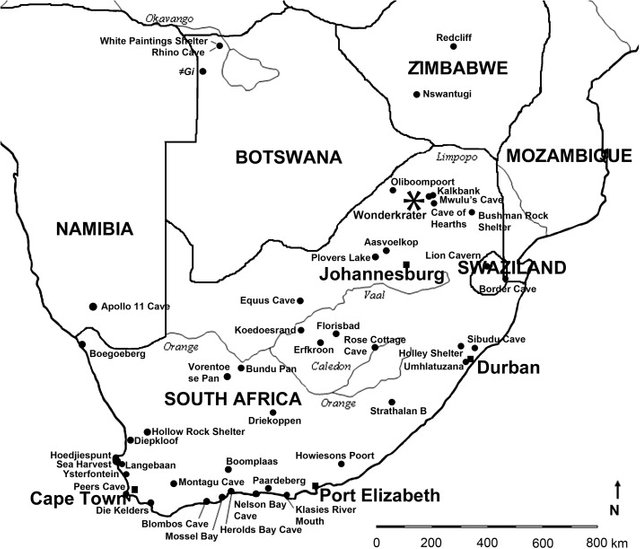
[1]
Habitation
During the Middle Stone Age (MSA) a wide variety of sites were occupied and different habitats were exploited. It is clear that greater mobility was achieved during both the MSA and the LSA, given the evidence of occupation from the coast to the high mountainous regions (Deacon 1995:128). Cave occupation sequences provide most of the evidence for MSA subsistence patterns and environmental adaptions. Some sites seem to indicate that workshops were located near sources of preferred raw material.
The Utilization of fire
Definite hearths are obvious at many cave sites, sometimes occurring as isolated features and sometimes as accumulations of multiple hearths, as at Klasies River Mouth.
These hearths indicate that MSA people could make fire deliberately. According to Henderson (1992) the spatial distribution of plotted stone artefacts and faunal remains gives us information about certain aspects of the behaviour of the early modern humans who lived in the Klasies River Cave complex between 90 000 and 60 000 years ago.
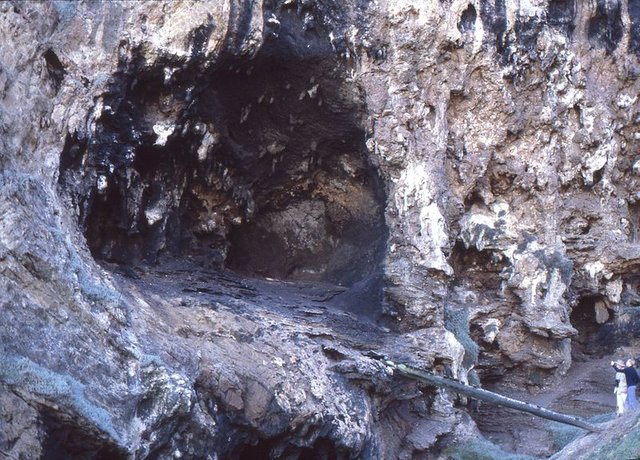
[2] Klasies River Mouth Cave Entrance
Ash features from stratigraphic units are interpreted as small domestic hearths which were used in the preparation of shellfish and possibly other foods. Furthermore, it is significant that hearths from the MSA layers at Bloomplaas are identical to those in the LSA.
The utilization of plants
The information we have about the MSA people's exploitation of plant foods is meagre. Plant remains from MSA sites in South Africa are much less common than that found in Holocene deposits. This is due to poor preservation and because plant food was possibly not as important to the hunter-gatherer diet during the MSA as it was during LSA (Plant food remains are particularly abundant in LSA deposits from the late Holocene). Grindstones, although rare, are mostly found in areas such as the former Transvaal and Kwa-Zulu Natal, where ethnographic evidence suggests more reliance on underground bulbs and corms. Although plant remains are under-represented in the MSA, it is assumed that vegetable foods played an important part in the diet of all hunting groups, as is evident in the ethnography of the San. (Ethnography means the scientific study of human groupings).
Ethnographic studies of modern Kalahari forager communities are consistent in showing that a larger part of the nutrition, 80% or more, is provided by plant foods (Deacon 1993:86).

[3] Border Cave Mouth
Organic material is only infrequently preserved in MSA deposits and, in the few instances where we have more than lithic evidence, these remains originated mainly from cave sites. Apart from the plant remains found at Bushmans Rock Shelter and Border Cave, little information on the exploitation of plant resources is available. The Howiesons Poort levels at Klasies River Mouth are associated with carbonised geophytes residues, which suggests that the MSA inhabitants burned the veld to stimulate the growth of underground bulbs.
Evidence for plant food exploitation at Umhlatuzana comes from seeds of edible and medicinal plants and also from the recovery of a grindstone and grindstone fragments. One grindstone was found in layers dated to 27 800 BP and grindstone fragments were found in layers dated to 13 300 to 45 200 BP, suggesting that plant foods were being processed at that time. The evidence from Umhlatuzana suggests that plant foods may have played a significantly greater role in subsistence strategies during the Late Pleistocene than previously thought.
At Strathalan Cave B in the northeastern Cape, a variety of plant remains were recovered because of exceptional preservation conditions (Opperman & Heydenrych 1990). Concentrations of inedible residues of a variety of geophytes were found in some areas of the cave.
The utilization of fauna
Detailed faunal studies show a common hunting pattern, suggesting that MSA people had efficient hunting techniques and that they concentrated on medium to large herbivores as their meat source. At Klasies River Mouth the many points and pointed flake-blades, sometimes with notched edges, are interpreted as probably forming part of stone-tipped spears used as hunting weapons. A similar stone point found between the ribs of a mammoth in England shows the lethal effect of such hunting weapons.
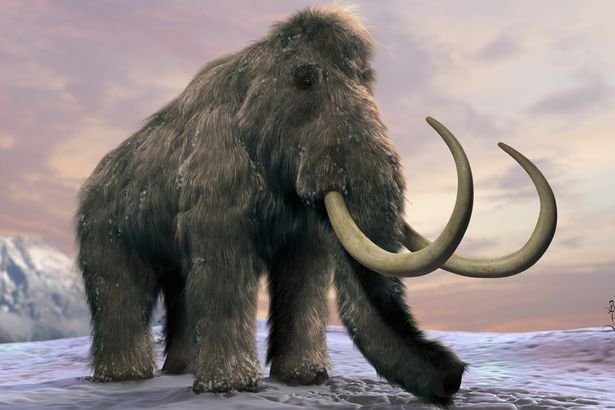
[4] Woolly Mammoth
High mortality profiles for all age groups in herd animals such as eland may indicate group hunting methods whereby whole herds were driven into traps or cliffs. The remains of dangerous herbivores such as elephant and rhinoceros and larger carnivores are poorly represented, implying that they were possibly considered too dangerous to hunt regularly. Certain food items may also have been avoided because of tastes and taboos- this would account for their absence at sites (Thackeray 1993:418).
However, in other important respects, the MSA cave sites deposits show similar trends, such as the hunting pattern indicated above. It is suggested that there was a decrease in both scavenging and in the practice of bringing back marginal parts of carcasses. During the ESA, buthering took place at the kill site and the main parts of carcasses were generally consumed on the spot with only specific parts brought back to the home base. Scavenged body parts can be identified through marks left by carnivore gnawing and the by the cut marks over the carnivore teeth marks.
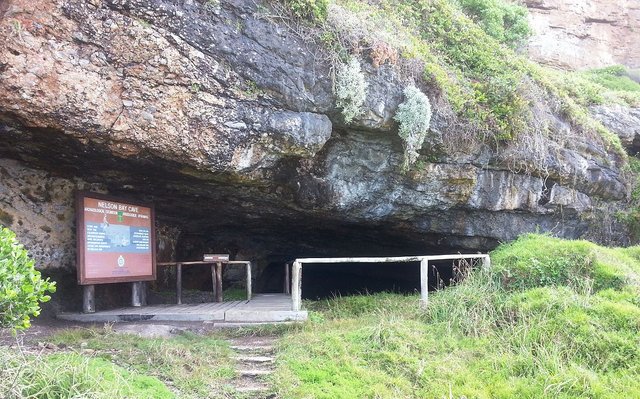
[5] Nelson Bay Cave
The above factors seem consistent with a behavioral shift from hunting large to small mammals across the Palaeolithic record. Stratigraphic sequences in caves such as at Die Kelders show a regular trend of increased hunting of relatively small species; the passage of time probably meant that the later stages of the MSA experienced a different environmental setting. Various researchers interpret this as leading to a gradual move away from large hunting groups of the MSA to the smaller hunting bands of the LSA.
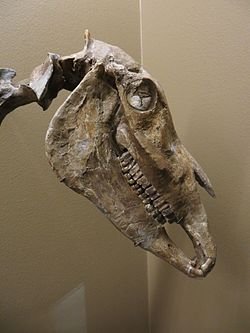
[6] Equus (genus)
A few faunal species which became extinct at the onset of the LSA are present at MSA sites, namely the giant buffalo, Pelorovis antiquus, the giant hartebeest, Megalotragus priscus, the giant warthog, Stylochoerus, the giant Cape horse, Equus capensis, and two species of springbok, Antidorcas australis and A.bondi. Environmental changes do not offer sufficient explanation for these extinctions, given that they survived similar stressed environmental circumstances during the MSA.Instead, the suggestion is that LSA people hunted so efficiently that the reproductive capacity of these animals species was impaired to the point that they became extinct before the Holocene. Archaic forms that occur in the ESA Acheulian context such as three-toed horses, sabre-tooth cats and short-necked giraffes are absent, indicating beyond doubt the younger age MSA assemblages.
The utilization of marine resources
Klasies River Mouth on the Tsitsikamma coast of the southern Cape has provided an excellent stratigraphic record of the MSA. This site has yeilded much needed information on MSA subsistence strategies, and shows evidence of changing technological patterns over time. This site, together with Die Kelders 1, Herolds Bay and two middens (shell mounds) at Saldana Bay have provided the earliest evidence in the world for large-scale exploitation of marine resources. Abundant remains of molluscs, as well as the remains of seals and penguins, were found. Both seals and penguins are relatively easy to exploit, perhaps explaining their abundance at these sites. Although nothing was found in the way of needles or awls for the manufacture of clothing it is possible that seal was intensively hunted as much for its fur as its meat.
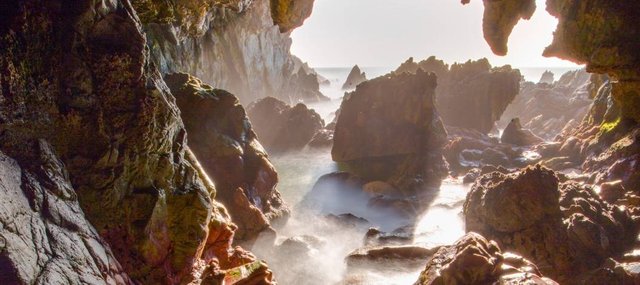
[7] Die Kelders Cave
The remains of fish and flying birds are relatively rare. This may imply that the technology of the MSA people was not sufficiently developed to exploit these resources. On the other hand, such remmains may not have been in particular demand as raw material in the manufacture of artefacts, as was the case during the LSA.
Some of the MSA sites are now submerged as a result of rising sea levels at the onset of the Holocene and it is therefore impossible to obtain evidence of perhaps more widespread exploitation of marine resources. However, one site characterised by a sea level currently similar to that during periods within the MSA, is Blombos Cave in the Southern Cape. The site has recently yeilded early evidence for fishing practices. Fish bones belonging to large specimens were recovered, which suggests that they were brought into the cave by humans rather than seabirds (Henshilwood& Sealy 1998:3).
Organisation of space
The hearths identified at the Klasies River Cave complex, which were repeatedly placed in one part of a unit along with concentrations of burnt shell, suggest that there was possibly some consistency in the organisation of space within the shelter.
The discreteness of the hearths and their size suggests each represents the domestic focus of a nuclear family and ethnography would point to this being the domain of a particular woman (Deacon 1993:89).
Organisation of the living area at Strathalan Cave B is indicated by the position of grassy bedding heaps found adjacent to the hearths. Lenses of burnt residues of geophytes, similar to some lenses in the later Holocene levels at Melkhoutboom Cave, were found in the Howiesons Poort Layers at Klasies River Mouth. This indicates that MSA people used plant foods and organised space in ways similar to those of the LSA people during the Holocene.
References:
~ Deacon 1995:128
~ Henderson 1992
~ Opperman & Heydenrych 1990
~ Thackeray 1993:418
~ Henshilwood& Sealy 1998:3
~ Deacon 1993:89
~ [1]
~ [2]
~ [3]
~ [4]
~ [5]
~ [6]
~ [7]
Thank you for reading.
Thank you @foundation for this amazing SteemSTEM gif


A lot of effort has been put in this article. thanks for sharing @zest.
Great Piece @zest. Enjoyed the read!!
Hi @huitemae, Thank you so much :)
"ethnography would point to this being the domain of a particular woman" - So, women, back to hearths! 😆
Thank you @zest, amazing content. 👍🏼
You caught that @laylahsophia :) , Thank you so much for your comment and support.
very good
Wow, that's cool. Thanks.
Congratulations @zest, this post is the fifth most rewarded post (based on pending payouts) in the last 12 hours written by a User account holder (accounts that hold between 0.1 and 1.0 Mega Vests). The total number of posts by User account holders during this period was 992 and the total pending payments to posts in this category was $1948.37. To see the full list of highest paid posts across all accounts categories, click here.
If you do not wish to receive these messages in future, please reply stop to this comment.
https://steemit.com/group/@naeemahmed/attract-everyone
please upvote me and follow me